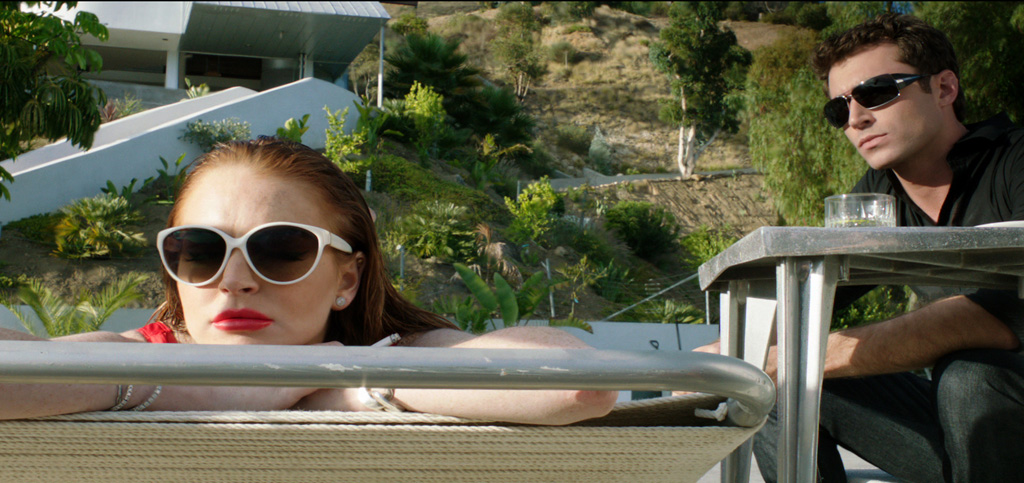A funny thing happened after leaving a screening at “The Canyons” on Monday night. Seeing the latest movie from Paul Schrader inside a traditional theater at all might’ve constituted that funny thing since the director has been insistent on calling “The Canyons” a “post-theatrical experience,” but no, it was across the street at a restaurant where I was having dinner with a friend and discussing the lurid thriller when a woman leaned in from the next table over and asked, “What did you think of it?”
Undoubtedly, this will be a rare exchange since “The Canyons” will be watched mostly in the privacy of homes on VOD and I can’t envision, even in spite of a four-way sex scene involving Lindsay Lohan, sparking enough discussion of its artistic merits to carry the conversation beyond the film’s current publicity blitzkrieg which has largely been about the unconventional way it was made. Yet beyond the film’s roots on Kickstarter, the baiting of cinephiles who still appreciate the moviegoing experience with images of dilapidated single-screens in its trailer and its opening salvo, and the casting of Lohan opposite adult film star James Deen, there’s something provocative about the film that has nothing to do with the infamous production of it.
As Schrader said during his introduction before the screening at UCLA’s Billy Wilder Theater at the Hammer Museum, “We put together some polarizing elements and I find myself in the odd position of being the least polarizing of the boldfaced names involved.” And it’s true that while there are hints of the same man who guided “American Gigolo” to fruition, he is largely a steadying hand for conveying the otherwise unwieldy thoughts of Bret Easton Ellis, who appears to have found the perfect vehicle for his brand of nihilism. Ever since Ellis’ first novel about Hollywood excess “Less Than Zero” was adapted for the screen in 1987, scores of talented filmmakers have been attracted to his work for the patina of cool that it exudes and have often come away with mixed results since they attempt to get under the surface and discover there might not be much there. However, unable to afford the usual assortment of fresh-faced stars that have often populated adaptations of Ellis’ books, “The Canyons” has the calculation and desperation of its characters laid bare by a cast that finally resembles the coldblooded types he puts front and center.
Essentially, the film revolves around Christian, a movie producer (Deen) who makes B-pictures from inherited wealth and is obsessed with keeping tabs on his girlfriend Tara (Lohan), an actress whose best days are likely behind her, despite the fact he enjoys a number of different sexual partners, both with Tara and without. That last part is why, from a plot standpoint, nothing in “The Canyons” really makes much sense as Christian lets his jealousy get the better of him once he suspects Tara is having an affair with Ryan (Nolan Funk), the star of his latest slasher film being shot in New Mexico and makes it his mission to destroy his life.
Deen can’t be relied upon to pull off such self-destructive behavior if there was supposed to be any actual psychological meaning behind it, but in playing the spoiled, bored and unfazed Christian, he embodies what’s always seemed like Ellis’ ideal leading man where feelings don’t register at all, only the mechanics of how to get revenge on those who have wronged him. Whereas the more experienced likes of Christian Bale and James Van Der Beek have had to withhold and eventually explode in similar roles as ticking time bombs, Deen simply is, demonstrating no change in his behavior that makes his character all the more chilling, if nonrelatable otherwise.
Likewise, Lohan, whose performance appears to fluctuate with what mood she was in on the day, represents the derailed decadence that Ellis’ characters so often aspire to without care of the consequences, with the actress occasionally allowing the audience to look past some unfortunate plastic surgery to see the person audiences once connected with. The rest of the cast are unburdened by such already established relationships, or baggage depending on your outlook, but with largely wooden performances, fill out Ellis’ world appropriately with everyone out for themselves and incapable of listening to others.
Such disconnect requires a viewer to meet “The Canyons” on its own terms. But in fact besides some peculiar editing choices and less of Ellis’ acidic dialogue than would be expected, fans of the author will no doubt be pleased to see his work undiluted, though in planning for a post-theatrical experience, he and Schrader may not have accounted for the film’s languid pacing, the rhythm of which was oddly compelling when giving over my whole attention in a theater, but I couldn’t imagine sitting through it with any distractions nearby at home.
While the details of the production that Schrader spoke of during the post-screening Q & A have mostly been covered extensively elsewhere, but he did share some interesting tidbits that seemed exclusive to the crowd in Los Angeles where the film is opening Friday at the Sundance Sunset in addition to its VOD run. When someone asked whether he gave any notes to Ellis, he said that although “Bret and I really aren’t on the same page, but we are in the same book,” this was the only script he didn’t touch besides “The Comfort of Strangers” when he worked with Harold Pinter. Schrader also said that from the start, he used the idea of making it directly for VOD as a guiding principle for the story, telling the cast at the film’s first read through of the script, “this is the story of some twentysomething Angelenos who went to the movies, but then the theater closed and they stayed in line because they had nowhere else to go.”
He also had some choice words about the MPAA, sounding relieved that after putting up his own money for the film and deciding against a traditional theatrical rollout he wouldn’t need to face them, although that didn’t prevent him from putting his own limits on the film.
“Why bother?” Schrader asked, when responding to a question about getting a rating for the film. “Why pay the MPAA that fee they charge? They’re just another one of the dinosaurs wandering around La Brea. There’s 500 theaters in this country that don’t require a rating and we’re not going to be in the slightest fraction of those anyway because this was a made-for-VOD concept. In fact, I had an argument with IFC because they wanted to get a rating and I said, that’s against the principle of why we did this.”
He added, “Now, I didn’t make it explicit porn, but that was a very clear choice that had nothing to do with the rating system. It has to do with the fact that I do not think long form narrative and explicit sexuality work together period. They never have, I don’t think they ever will. There used to be a myth that you could do a crossover film with hardcore action and movie stars. That is a false myth. It works on different parts of the brain. The part of the brain that is stimulated by long form narrative is a different part of the brain than is stimulated by explicit imagery. They don’t work well together and this notion of having longform mainstream porn was a myth from the ’70s and ’80s and I knew it was a myth and I was never going to go there.”




